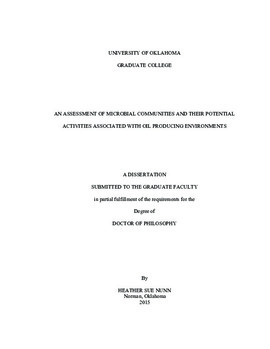| dc.description.abstract | Microbial populations have been found in oil-associated environments as early as the 1920s. The proliferation and metabolic activities of these microorganisms can have profound deleterious effects on the infrastructure associated with oil reservoirs, production, transport and storage. Biodegradation of hydrocarbons by reservoir microorganisms can lead to the formation of ‘heavy oil’ that is of lower economic value and is more difficult to recover. Some members of reservoir microbial communities also participate in microbial influenced corrosion. By applying modern sequencing technologies, much can be learned about the microorganisms present and their metabolic capabilities. The focus of this dissertation was to provide a comprehensive characterization of microbial communities in two oil production facilities and define their metabolic activity by profiling metabolites of hydrocarbons and sequencing their metagenomes.
The most common samples available from oil production facilities are fluids collected at valve openings. These samples are chemically and biologically representative of the bulk fluids at any given location within an oil facility (e.g. pipelines). Microorganisms commonly attach to surfaces and form biofilms that can provide the microbial inhabitants protection from the external environment, allow for localized changes in chemistry, and represent sites of corrosion. Common maintenance of pipelines includes the use of “pigs” which physically disrupt and remove biofilms, corrosion products, and other solids associated with the inner surfaces of a pipeline. Libraries of partial 16S rRNA gene sequences were used to compare the microbial communities in bulk fluids from several locations throughout an oil production facility with the community associated with a “pig envelope”, the fluids enriched with solids removed by a pig. The microbial communities in bulk fluids and biofilms of the oil production facility contained only a few taxa. All samples had similar compositions, but different structure (relative abundances of taxa). An estimation of population density based on qPCR of 16S rRNA gene copy number showed that there was a five-fold increase in the number of bacteria in the pig envelope. The numerically abundant taxa were members of the genera Thermoanaerobacter, Thermacetogenium and Thermovirga, which should be studied further to determine their ability to degrade hydrocarbons and influence corrosion.
The community structure, genomic potential, and function of microbial assemblages from two oilfields under different management practices were characterized to measure their potential for hydrocarbon biodegradation. High throughput sequencing of 16S rRNA genes was combined with shotgun metagenomic sequencing and a targeted environmental metabolomics survey to interrogate two oil production facilities. The genomic potential for the abundant taxa was thoroughly interrogated for currently known pathways for hydrocarbon metabolism. Several sequences were identified that are closely related to known hydrocarbon degradation genes; however, there is no conclusive evidence that directly links these taxa and the hydrocarbon metabolites that were identified.
The presence of microorganisms and putative signature metabolites in oil-associated environments suggests hydrocarbon degradation is occurring. Hydrocarbon degradation causes souring and ‘heavy oil’ which is harder to extract and of less value. Additionally, when microorganisms are identified in close association with corroded surfaces, they are potentially implicated as participating in surface corrosion. In order to directly associate a particular microorganism with a specific activity, there is still a need for controlled experiments. A better understanding of the microorganisms and their activities in oil production facilities will lead to improved monitoring and mitigation for the future. | en_US |
